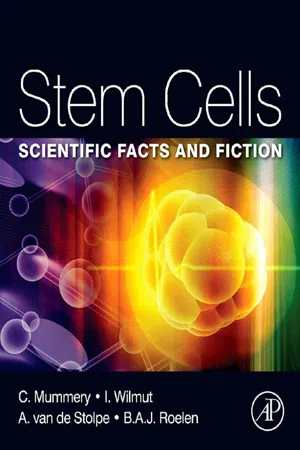Cell Nucleus
The cell nucleus is a membrane-bound organelle found in eukaryotic cells, containing the genetic material in the form of DNA. It serves as the control center of the cell, regulating gene expression and coordinating cellular activities. The nucleus is essential for cell division, growth, and reproduction, playing a crucial role in maintaining the integrity and function of the cell.
8 Key excerpts on "Cell Nucleus"
- eBook - ePub
Genetic Engineering Fundamentals
An Introduction to Principles and Applications
- John Kammermeyer(Author)
- 2017(Publication Date)
- CRC Press(Publisher)
...The cell is surrounded by a lipid bilayer containing a variety of proteins; the cytoplasm contains ribosomes; and the genetic information of eukaryotes is contained in its DNA. Nucleus The eukaryotic cell has a well-defined nucleus surrounded by a double nuclear membrane containing large nuclear pores (100 nm). The space between the two membranes is called the perinuclear space, and the nuclear membrane appears to arise from an extension of parts of the endoplasmic reticulum. The nucleus appears spheroid in electron micrographs of most eukaryotic cells, but in some cases, such as polymorphonuclear leukocytes, nuclear lobulation occurs that appears to give multiple nuclei when the cell is sectioned in preparation for electron microscopy. Most of the genetic material is located within the nucleus, in the form of chromosomes. When the cell divides, the nucleus replicates and divides before division of the cytoplasm occurs. Since the nucleus contains the DNA of the cell, it is the site of DNA-directed RNA synthesis (transcription). This RNA is then processed and transported through the nuclear pores to the cytoplasm where translation occurs (see Chap. 3). A nucleolus is usually present within the nucleus of eukaryotic cells. It is the site of synthesis of ribosomal RNA and the site where ribosomal RNA and ribosomal proteins are assembled into ribosomes. The DNA that codes for ribosomal RNA is contained within the nucleolus and is repeated, with several hundred copies per haploid genome. Chromosomes The word chromosome was coined by an early investigator, Dr. Waldeyer of Germany, in 1888. Chromosomes appear as “colored bodies” and, when condensed during mitosis, are frequently visible under a light microscope. The portions of the nucleus that are stainable are called chromatin, and consist of proteins complexed with DNA...
- eBook - ePub
- Thomas D. Pollard, William C. Earnshaw, Jennifer Lippincott-Schwartz, Graham Johnson(Authors)
- 2016(Publication Date)
- Elsevier(Publisher)
...In skin, defects in these attachments cause blistering diseases. Nucleus The nuclear envelope is a double membrane that separates the nucleus from the cytoplasm (Fig. 1.11). All traffic into and out of the nucleus passes through nuclear pores that bridge the double membranes. Inbound traffic includes all nuclear proteins and ribosomal proteins destined for the nucleolus. Outbound traffic includes mRNAs and ribosomal subunits. FIGURE 1.11 ELECTRON MICROGRAPH OF A THIN SECTION OF A NUCLEUS. (Courtesy Don Fawcett, Harvard Medical School, Boston, MA.) The nucleus stores genetic information in extraordinarily long DNA molecules called chromosomes. Remarkably, portions of genes encoding proteins and structural RNAs make up only a small fraction (<2%) of the 3 billion nucleotide pairs in human DNA, but more than 50% of the 97 million nucleotide pairs in a nematode worm. Regions of DNA called telomeres stabilize the ends of chromosomes, and other DNA sequences organize centromeres that direct the distribution of chromosomes to daughter cells when cells divide. Much of the DNA encodes a myriad of RNAs with regulatory activities. The DNA and its associated proteins are called chromatin (Fig. 1.5). Interactions with histones and other proteins fold each chromosome compactly enough to fit into discrete territories inside the nucleus. During mitosis, chromosomes condense and reorganize into separate structural units suitable for sorting into daughter cells (Fig. 1.5). Regulatory proteins called transcription factors turn specific genes on and off in response to genetic, developmental, and environmental signals. Enzymes called polymerases make RNA copies of active genes, a process called transcription. mRNAs specify the amino acid sequences of proteins. Other RNAs have structural, regulatory, or catalytic functions. Most newly synthesized RNAs are processed extensively before they are ready for use...
- eBook - ePub
Stem Cells
Scientific Facts and Fiction
- Christine L. Mummery, Anja van de Stolpe, Bernard Roelen, Hans Clevers(Authors)
- 2010(Publication Date)
- Academic Press(Publisher)
...Most cell organelles are themselves separated from the cytoplasm by their own membranes. The form of the cell is determined and supported by the cytoskeleton, a flexible scaffolding composed of polymers of protein molecules which form a network that shapes the cell and allows it to move and “walk”. Inside the cell countless proteins – sometimes in cooperation with RNA molecules – facilitate the chemical and physical reactions and transport of other molecules required to carry out specific cellular functions. The most prominent organelle viewed under the microscope is the nucleus. This contains the chromosomes, which are in part made up of DNA – one long molecule of DNA per chromosome – representing the Schematic representation of an animal cell. The cell contains a fluid called the cytoplasm, enclosed by a cell membrane. The nucleus contains the genetic information, the DNA. The shape of the cells is determined by their cytoskeleton. Proteins and lipids are generated and assembled in the endoplasmic reticulum. The Golgi apparatus is then responsible for further transport within the cell. Lysosome s are small vesicles with enzymes that can break down cellular structures and proteins that are no longer required, while the energy necessary for the cell is generated by the mitochondria. organism’s blueprint. Although cells can have different shapes and functions, the DNA sequence in all cells of a given individual is in principle identical (with the exception of certain blood cells). Other prominent structures in the cell are the mitochondria. These organelles are present in large numbers and generate the energy required by the cell. Cells with very large energy requirements, like heart cells, contain correspondingly higher numbers of mitochondria. Energy is also required, among other things, for creating messenger RNA (mRNA) and linking amino acids to each other in the ribosomes to form proteins...
- eBook - ePub
- Jo Ann Eurell, Brian L. Frappier, Jo Ann Eurell, Brian L. Frappier(Authors)
- 2013(Publication Date)
- Wiley-Blackwell(Publisher)
...1 Cytology LARS-INGE LARSSON General Overview Cell Membrane Nucleus Nuclear Envelope Nucleoplasm Nucleoli Cytosol Organelles Rough and Smooth Endoplasmic Reticulum and Ribosomes Golgi Complex and Vesicular Transport Mitochondria Peroxisomes Cytoskeleton Microtubules Microfilaments Intermediate Filaments Inclusions Cell Surface Modifications Cell Cycle, Cell Division, and Apoptosis From Cells to Tissues Intercellular Junctions Cell Communication GENERAL OVERVIEW The cell is the smallest unit of life, and all living matter (protoplasm) is composed of cells. Cells possess the unique abilities to replicate and to create energy from inanimate matter, which are qualities that characterize life itself. Many living creatures are unicellular (i.e., consist of a single cell), but higher organisms are comprised of a multiplicity of cells that specialize in different functions including absorption, digestion, and excretion. In primitive prokaryotic cells, like bacteria, there is little organization of the many molecules that are needed for the life processes. In contrast, in eukaryotic organisms, the genetic material is organized in a nucleus (karyon) and many other processes have become restricted to membrane-bounded organelles. Such compartmentation prevents unordered mixing of different biochemical pathways, thus allowing for more sophisticated functions. The compartmentation also allows the cells to increase in size by ordered delivery of membrane-delimited molecules to their appropriate destinations. Thus, bacteria only reach 1 to 5 µm in size, while most eukaryotic cells are 5 to 50 µm. Eukaryotic cell structure and function thus depend upon membranes and membrane-enclosed structures. The cell itself is delimited by the cell membrane. The cytoplasm consists of organelles, inclusions, and cytoskeletal components enclosed in a semiviscous liquid, the cytosol (Fig. 1-1)...
- eBook - ePub
Cancer
Basic Science and Clinical Aspects
- Craig A. Almeida, Sheila A. Barry(Authors)
- 2011(Publication Date)
- Wiley-Blackwell(Publisher)
...What do you suppose are some functions of peripheral proteins? CELL STRUCTURE AND FUNCTION Each type of cell in the body must be able to carry out its array of highly evolved and indispensable functions. Therefore, despite the commonalities that all cells share, each cell type has a unique composition and arsenal of specialized structures. Figure 2.14 is a composite illustration of a typical human cell with numerous phospholipid membrane-bound internal structures apparent. These membrane-bound structures allow for compartmentalization of the cell so that particular functions will occur within particular intracellular locations. These structures are analogous to tiny organs, and as such they are appropriately termed organelles. Nucleus is the control center of the cell The most prominent organelle is the nucleus (Figure 2.14). It is where the chromosomes are located and where the processes of DNA replication and transcription take place. After being synthesized in the nucleus, mRNA molecules are transported into the cytosol, the region of the cell between the nuclear and plasma membranes, through transport proteins located in the nuclear membrane. Found throughout the cytosol are ribosomes, the sites where mRNA molecules are translated into proteins (Figure 2.14). Roles of endoplasmic reticulum and Golgi in modifying and trafficking proteins and lipids The nuclear membrane is continuous with the membrane of the endo plasmic reticulum (ER) (Figure 2.14). The smooth endoplasmic reticulum, the first of two forms of the organelle, is involved in the synthesis of various types of membrane lipids and steroid hormones as well as the degradation of drugs and poisonous molecules into nontoxic substances. The rough endoplasmic reticulum has a knobby appearance to the cytoplasmic side of the membrane when viewed under the microscope because ribosomes are bound to it...
- eBook - ePub
- Laurie Ann Callihan(Author)
- 2013(Publication Date)
- Research & Education Association(Publisher)
...They have a double membrane; the internal membrane is folded. Cellular respiration reactions occur along the folds of the internal membrane (called cristae). Mitochondria are thought to be an evolved form of primitive bacteria (prokaryotic cells) that lived in a symbiotic relationship with eukaryotic cells more than 2 billion years ago. This concept, known as the endosymbiont hypothesis, is a plausible explanation of how mitochondria, which have many of the necessary components for life on their own, became an integral part of eukaryotic cells. 10. The nucleus is an organelle surrounded by two lipid bilayer membranes. The nucleus contains chromosomes, nuclear pores, nucleoplasm, and a nucleolus. The nucleolus (10a) is a rounded area within the nucleus of the cell where ribosomal RNA is synthesized. This rRNA is incorporated into ribosomes after exiting the nucleus. Several nucleoli (plural of nucleolus) can exist within a nucleus. The nuclear membrane (10b) is the boundary between the nucleus and the cytoplasm. The nuclear membrane is actually a double membrane, which allows for the entrance and exit of certain molecules through the nuclear pores. Nuclear pores (10c) are points at which the double nuclear membrane fuses together, forming a passageway between the inside of the nucleus and the cytoplasm outside the nucleus. Nuclear pores allow the cell to selectively move molecules in and out of the nucleus. There are many pores scattered about the surface of the nuclear membrane. Plant Cells The structure of plant cells differs noticeably from animal cells with the addition of three organelles: the cell wall, the chloroplasts, and the central vacuole. In Figure 3–9, the organelles numbered 1 to 7 function the same way in plant cells as in animal cells (see above). 1. Golgi apparatus 2. Mitochondria 3. Rough endoplasmic reticulum 4. Ribosome 5. Nucleus 6. Nucleolus 7. Smooth endoplasmic reticulum 8. Cell walls surround plant cells...
- eBook - ePub
Advanced Molecular Biology
A Concise Reference
- Richard Twyman(Author)
- 2018(Publication Date)
- Garland Science(Publisher)
...Chapter 3 Chromatin Fundamental concepts and definitions The DNA in eukaryotic chromosomes exists in a complex with an approximately equal mass of protein, forming a highly ordered nucleoprotein substance termed chromatin. The protein component of chromatin consists primarily of histones plus a small amount of other proteins, collectively termed nonhistones. The histones are relatively homogeneous and are responsible for the fundamental aspects of chromatin structure, whereas the nonhistone proteins are heterogeneous and perform many different functions. The DNA in each chromosome is a single, very long molecule (the unineme model). A eukaryotic nucleus is no more than 1 μm in diameter, yet it contains up to 10 9 bp of DNA, which would measure several meters if extended. The DNA must therefore be highly folded, a property expressed as its packaging ratio — the ratio of the length of DNA in the nucleus to its theoretical free length. The packaging ratio in the interphase nucleus is approximately 10 3. The packaging of DNA into chromatin is highly organized and is achieved through several hierarchical orders of structure. Chromatin is not merely a structural phenomenon, but has a great impact on gene activity. The organization of chromatin is used to regulate gene expression and is a basis of epigenetic cell memory. 3.1 Nucleosomes Nucleosome structure. Nucleosomes are the fundamental units of chromatin. They are found in all eukaryotes (with the exception of the dinoflagellates) and are conserved in structure. When nuclei are lysed in a low salt solution, the chromatin decondenses and nucleosomes can be observed resembling beads on a string. The relationship between DNA and the nucleosome can be investigated using nucleases (Figure 3.1). Limiting digestion of decondensed chromatin separates the nucleosomes into short fragments consisting of single nucleosome units (mononucleosomes) and multimers thereof...
- eBook - ePub
- Chang-Hui Shen(Author)
- 2019(Publication Date)
- Academic Press(Publisher)
...Chapter 5 The Genome Abstract The most important function of genetic materials is to carry genes—the functional units of heredity. The genetic information specifies all the RNA and protein molecules, and directs when, in what types of cells, and in what quantity each protein is to be made. In eukaryotes, the genes in the nucleus are distributed between a set of different chromosomes which makes up the genome. Therefore, the genome is the complete set of genes of an organism. Ultimately, it is defined by the complete DNA sequence. For example, the human genome, which contains 3.3 × 10 9 nucleotides, is distributed over 23 pairs of chromosomes. Each chromosome consists of a single, enormously long, linear DNA molecule associated with histone proteins that fold and pack the fine DNA thread into a more compact structure known as chromatin...







